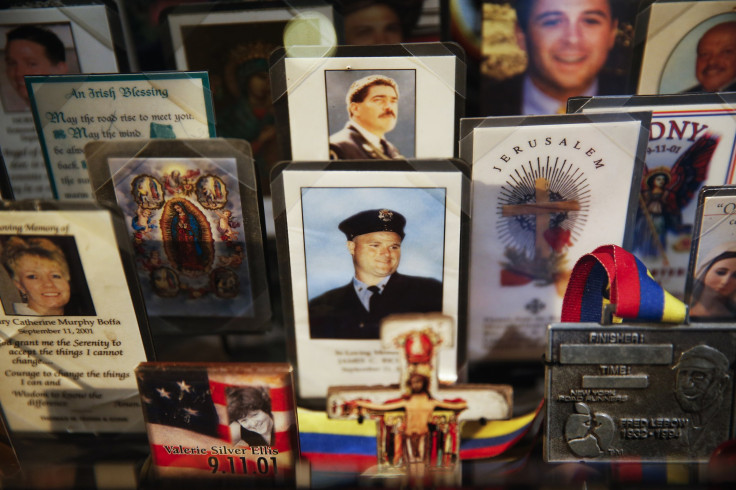9/11 Memorial Museum Among New York's Most Popular Attractions Months After Grand Opening

The walls are lined with images of horrified faces turned toward the sky. Unidentified voices fill room after room, recounting the stories of pain and loss: a plane crash, screaming office workers, another plane crash, frenzied police officers, missing friends, relatives and colleagues. Steps away from the emotional exhibits, a gift shop sells keychains, stuffed animals and other keepsakes recalling the Sept. 11, 2001 terrorist attacks. Since its opening in May, the National September 11 Memorial and Museum has become one of New York City's most popular tourist attractions, drawing visitors from across the globe to a site that has become a rare combination of tourist pageantry and burial ground. The museum is also home to some 8,000 unidentified human remains.
Museum officials have said the 110,000-square-foot attraction was designed as a place for quiet reflection. On a recent visit, visitors posed for pictures amid rubble saved from the World Trade Center as others openly wept. Boxes of tissues were made available near some of the more graphic exhibits, including one featuring photographs of office workers leaping to their deaths as flames consumed the top floors of the Twin Towers. Another exhibit shows some of the "missing" posters that papered New York City in the months after the attacks as relatives and friends searched for their loved ones, many of whom were eventually declared lost to the towering piles of debris. It took nine months to remove about 1.8 million tons of waste from the World Trade Center site after the attacks.
Since opening on Sept. 11, 2011, the memorial site has attracted more than 14 million people, and the museum has drawn nearly a million visitors since opening just four months ago. In comparison, the Museum of Natural History draws about 5 million visitors each year and the Statue of Liberty has more than 3 million annual visitors. This is the first year the National September 11 Memorial and Museum will be open to the public on the anniversary of the attacks.
A note featured in the museum recalls the many fruitless searches for survivors after the plane crashes at the World Trade Center: "We work around the two mountains of debris where we still hope to find people alive. Sometimes we hear 'quiet'.... For a few minutes we hope and wait but every time it is a disappointment, as they find no sign, and we start to dig again."
The terrorist plot unfolded on the morning of Sept. 11, 2001, when 19 Islamist extremists hijacked four commercial airplanes with the intent of striking four of the nation's most symbolic sites. They successfully crashed two of the airliners into the Twin Towers in New York City, with the subsequent collapse of the skyscrapers resulting in the destruction of the entire World Trade Center complex. A third plane struck the Pentagon in Arlington, Virginia. The fourth crashed into an empty field in western Pennsylvania after passengers learned of the other attacks and attempted to stop the final one aimed at Washington, D.C. In all, 2,977 people were killed, including 400 first responders.
From its inception, the museum has incited both praise and anger. Faith leaders have questioned its portrayal of Islam, which critics say contributes to false prejudices that all Muslims support terrorism against the U.S. The museum's naked commercialism -- the gift shop also sells earrings and bowls -- has similarly sparked debate.
Tight security at the museum's entrance recalls the increased airport security policies implemented after the 2001 attacks. The museum also recounts the events of the Feb. 26, 1993, terrorist attack on the World Trade Center, when Islamist terrorists detonated explosives in the garage underneath the business complex, killing six people and injuring thousands.
The museum's historical exhibition explores the events that occurred before, on and after Sept. 11, 2001, including biographical details about Obama bin Laden, the al Qaeda leader behind the attacks. A separate space provides glossy photos and personal details about the men, women and children killed in the 2001 and 1993 terrorist attacks. A 10-minute video called "Rebirth at Ground Zero" documents the redesign and reconstruction of the World Trade Center after the 2001 attacks.
"If it weren't for the pain, you wouldn't know what joy was," a relative of one of the victims says during the video.
The museum is part of the redesigned World Trade Center still under construction. It houses more than 12,500 artifacts from the terrorist attack sites in New York, Pennsylvania and Virginia, including a pair of bloody shoes, a flashlight used to guide one office worker's escape and charred documents that fell from one of the towers after the plane crashes. It also features more than 23,000 photographs and more than 1,990 oral histories. The private, nonprofit memorial cost more than $700 million to build and boasts an operating budget of $60 million. Admission is $25 for adults and is free Tuesdays after 5 p.m.
The outdoor memorial near the museum entrance features a plaza of trees and two reflecting pools with the largest man-made waterfalls in North America set in the footprints of the original Twin Towers. The names of the victims frame the perimeters of the pools.
The Twin Towers were the centerpiece of the original World Trade Center, a 16-acre commercial complex built between 1966 and 1987 that included seven buildings, a large plaza and an underground shopping mall. More than 50,000 people worked at the complex.
“This is a rare archeological museum located at the very site where the history it documents and commemorates took place," Alice Greenwald, the museum's director, said in a statement after the grand opening in May. "At the heart of this museum is a fundamental conviction: that bearing witness to the unimaginable is the only way to imagine a way beyond it."
© Copyright IBTimes 2025. All rights reserved.






















